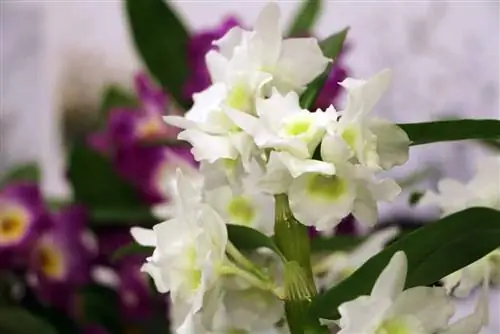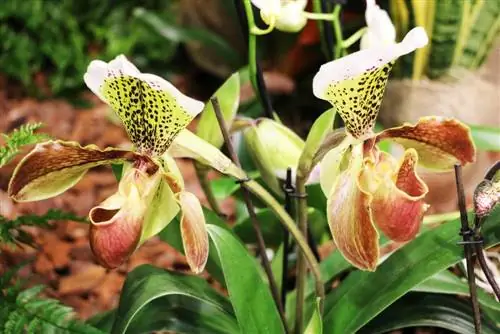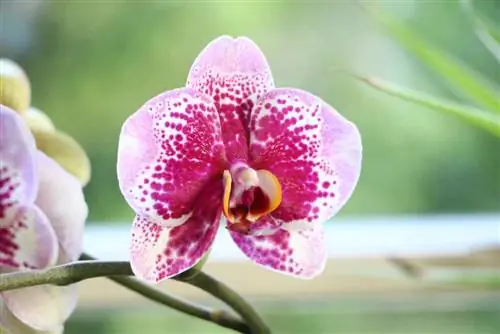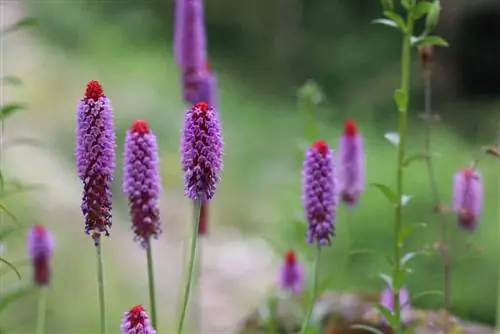- Author admin [email protected].
- Public 2023-12-17 03:39.
- Last modified 2025-01-24 12:45.
The flowers of the Dendrobium Nobile orchid appear in clusters on an upward shoot axis. The plant owes its other name, grape orchid, to this characteristic arrangement. With the help of a few tips and a little practice, caring for this beautiful ornamental plant is not particularly difficult. Under optimal growing conditions, the dendrobium repeatedly adorns itself with long-lasting, fragrant flowers.
Plant profile
- Flower colors: white, yellow, orange, red, pink, violet and color combinations
- Flower growth: directly on the stem from the leaf axils
- Leaves: elongated elliptical, alternate, about 10 cm long
- Growth height: up to 70 cm
- Beginning of flowering: winter / spring
Location
Grape orchids look best next to green plants that don't grow very tall (e.g. spider plants). The eye then automatically falls on the fascinating flowers of the exotic plant. When placed alone, the Dendrobium Nobile orchid confidently expresses its elegant elegance. In order for it to thrive, it needs a space that meets its requirements:
- as bright as possible but without bright midday sun
- East or west facing windows are tolerated
- Shade the window pane if necessary (e.g. with a translucent pleated blind)
- ideal ambient temperature: 15° to 21°C
- slightly cooler at night and during rest period
- never below 10°C
- not in the immediate vicinity of radiators and ovens
- protect from drafts
- Late summer stay outdoors possible (partly shaded)
Tip:
Snails view orchids as welcome food. Do not place orchids on the ground outside, but rather on an elevated place (shelf, stool, table) out of reach of snails to avoid ugly damage caused by feeding.
Planter
Orchid pots are designed so that water can drain easily. Constant wetness damages the roots. More and larger holes in the ground allow an excess of water to pass through. Planters for orchids are often made of transparent plastic, so that you can see the condition of the roots at any time. A planter, for example made of ceramic, which houses the plastic pot, ensures an attractive look. Decorative pots that have a raised area or edge on the inside so that the plant does not stand directly on the bottom of the pot are advantageous. In this way, the roots do not become waterlogged because excess water collects in the reservoir.
Tip:
For Dendrobium Nobile orchids, the pot must not be too spacious so that the substrate mixture dries quickly. Only choose a size larger if the container has actually become much too narrow for the plant.
Water
Dendrobium orchids are mainly found on trees in their native regions of Southeast Asia, Borneo, Australia, New Guinea and New Zealand. The mountain forests are regularly hit by heavy downpours. As the water rains down from the sky, grape orchids absorb the moisture through their foliage and aerial roots. When the rain stops, the water still on the plant trickles down.
Until the next rainfall, the remaining moisture evaporates from the sun and the surfaces of the plant dry out, including the roots. Dendrobium orchids therefore cannot stand permanently in moist soil. In order to copy watering in indoor cultivation as closely as possible to nature, experts recommend dipping. What you should pay attention to:
- Use lime-free water (rainwater or boiled or stale water)
- Water temperature: room temperature (otherwise there is a risk of cold shock)
- Water depth: up to the edge of the pot (more water washes out the substrate)
- wait until no more bubbles appear
- immerse for half an hour at most
- then let the pot drain on a coaster
- only then place in the regular planter
The ideal time interval for dipping depends on the local conditions. In a slightly warmer location or if the plant is only sprayed infrequently, it may need to be watered every week. In most cases, one dive every 2-3 weeks is sufficient for the Dendrobium Nobile orchid. The substrate should always be already dry. Whether the plant needs water again can also be determined by its weight. There isn't much moisture left in a light pot.
Tip:
In contrast to many other orchids, dendrobiums tolerate the classic watering method comparatively well, provided that very little water is always added to the pot.
Spraying
There is a lot of moisture in the air at the locations of the natural form in tropical forests. In the apartment, however, a very high water vapor content in the air is undesirable because humidity has an oppressive effect and there is a risk of mold growth on ceilings and walls. To ensure that the Dendrobium Nobile orchid still feels comfortable in indoor cultivation, we recommend briefly misting the leaves and aerial roots with soft water every day. An orchid display case is an alternative to permanently providing the plants with a warm, humid environment. Inside there is a climate that is comfortable for the exotic beauties, and in the living room the humidity is suitable for people.
Fertilize
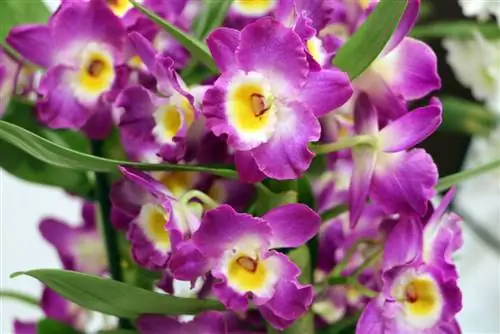
The Dendrobium Nobile orchid is content with relatively few nutrients. In this respect, you should not overdo fertilizing. It is sufficient if the immersion bath is enriched with orchid fertilizer every four weeks. For most products in liquid form, 5 ml is enough for one liter of water. To be on the safe side, read the instructions for use of the fertilizer you buy carefully so that the dose is correct. The information is on the back of the bottle.
Cutting
Pruning in the usual form is unnecessary for dendrobiums. Leaves that have turned yellow will fall off on their own or come off if you lightly pick at them. You only need to use scissors as soon as a shoot has withered and dried out. No more flowers are to be expected here because each stem only blooms once. Withered inflorescences can therefore be removed. The cut should be made as far down as possible at the base.
Rest phase
After the energy-sapping flowering, the Dendrobium Nobile orchid needs a while to recover. By this time the plant has usually already developed new pseudobulbs. In order for these shoots to grow strong and produce wonderful flowers, the grape orchid should initially be kept a little cooler (10°-15°C) and receive very little water. Fertilization should be avoided during the vegetation break, usually in autumn. After about 8 weeks, when the new shoots have reached a height of 5 cm, the orchid is given a warmer place, more water and fertilizer every four weeks.
Tip:
Possible places for the rest phase: light stairwell or cool bedroom.
Substrate
In their natural places on twigs and forks of branches, the leaves of the trees block out overly aggressive sun rays. On the other hand, the space at lofty heights provides more light than down on the ground. As epiphytes, Dendrobium Nobile orchids form aerial roots with which they cling to the tree. Even if moss and lichen grow on the branches and fallen leaves may provide some humus, the orchids are not used to a firm stand with roots anchored in the ground.
The plant not only absorbs moisture but also oxygen via its aerial roots. Orchid substrate is modeled on growth on trees. There is always some space between the coarse pieces of bark so that oxygen can reach the roots. Therefore, only use orchid substrate for your dendrobium so that the roots do not suffocate and rot.
Repotting
Orchid substrate is used up after 2 to 3 years. The pieces of bark that initially provided an air-permeable environment for the orchid roots are now beginning to rot. As the pieces crumble, the substrate compacts, enclosing the roots and depriving them of air to breathe. In this state, the substance also stores too much water. If the roots can no longer dry between dives, there is a risk of rot.
In order to continue to ensure the urgently needed oxygen supply, the Dendrobium Nobile orchid needs fresh substrate before the bark completely breaks down. Regardless, you may need a larger planter anyway. The best time is after the dormant phase, as soon as new growth becomes noticeable. When repotting, proceed as follows:
You need:
- fresh orchid substrate
- possibly a new orchid pot
- pointed, sharp scissors or knife that cuts well
Days ago:
Dip the planter into water so that the roots soak up water and become more elastic
Repotting instructions in individual steps:
- Carefully lift the plant out of the pot
- If necessary, press all around the edge of the pot so that the roots can loosen better
- if applicable Cut open the bottom of the pot if roots are stuck in it
- remove all roots completely from soil
- leave sucked-on substrate pieces in order not to damage the roots
- Inspect the root ball
- Disinfect scissors or knives to protect against pathogens
- he althy roots (green or silvery and plump) remain
- cut off dead roots (brown, dry and hollow)
- also remove old, shriveled pseudobulbs
- Then leave the plant in the air for 1 hour so that the wound areas close
- if the same pot is used again: empty and rinse with hot water
- Keep the plant with all roots in the pot
- place the new growth in the middle
- Fill in the substrate, including between the roots
- do not press with your fingers (risk of breaking roots)
- instead, gently push the pot on the table so that the substrate slides down
- Fill to the top, but do not cover the rhizome with new shoots (requires light)
- Do not water, dip or spray for one day (cuts must heal completely)
- fertilize again after 4 weeks
Diseases and pests

Incorrect care and unfavorable circumstances can cause the following diseases in Dendrobium Nobile orchids:
- Sunburn (light dried leaf areas with black edges)
- Root rot due to excessive soil moisture
- Gray mold caused by spraying too intensively
- Wrinkling due to irregular or insufficient watering
- Bacterial leaf spot (brown dots on underside of leaves): remove infected leaves
Lack of care may result in infestation with these pests:
- Scale insects
- mealybugs
- Aphids
- Spider mites
- Thrips
The earlier pests are discovered, the easier they are to combat. Therefore, check your grape orchid regularly for uninvited guests. Whether it is a disease caused by germs or a pest infestation, affected plants should be isolated immediately to prevent transmission to other plants. All types of pests are insects that weaken their host plants due to their sucking activity.
As an immediate measure, take a moistened piece of kitchen roll and try to wipe off as many of the pests as possible. As a next step, you can choose between commercially available biocides or tried-and-tested home remedies. For example, soft soap solution is considered an effective weapon against lice and other pests on houseplants.
Propagation
In our latitudes, seed capsules do not develop from flowers due to a lack of suitable pollinators. Manual insemination requires sensitivity and specialist knowledge. Propagation by plant division is also reserved for specialists in ornamental plant cultivation. But with a bit of luck, a daughter plant will emerge from the Dendrobium Nobile orchid, so that even enthusiastic hobby growers can successfully reproduce it.
But please wait until the child has formed at least three strong aerial roots. Only then is the young plant capable of an independent existence. Until then, don't forget the small roots when misting the mother plant every day. After being separated from the original plant, the offspring gets their own small pot with fresh orchid substrate.

